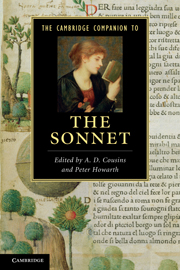Book contents
- Frontmatter
- Introduction
- 1 Contemporary poets and the sonnet
- 2 The sonnet and the lyric mode
- 3 The sonnet, subjectivity and gender
- 4 The English sonnet in manuscript, print and mass media
- 5 European beginnings and transmissions
- 6 Desire, discontent, parody
- 7 Shakespeare’s Sonnets
- 8 Sacred desire, forms of belief
- 9 Survival and change: the sonnet from Milton to the Romantics
- 10 The Romantic sonnet
- 11 The Victorian sonnet
- 12 The modern sonnet
- 13 The contemporary sonnet
- Further reading
- Index
10 - The Romantic sonnet
Published online by Cambridge University Press: 28 May 2011
- Frontmatter
- Introduction
- 1 Contemporary poets and the sonnet
- 2 The sonnet and the lyric mode
- 3 The sonnet, subjectivity and gender
- 4 The English sonnet in manuscript, print and mass media
- 5 European beginnings and transmissions
- 6 Desire, discontent, parody
- 7 Shakespeare’s Sonnets
- 8 Sacred desire, forms of belief
- 9 Survival and change: the sonnet from Milton to the Romantics
- 10 The Romantic sonnet
- 11 The Victorian sonnet
- 12 The modern sonnet
- 13 The contemporary sonnet
- Further reading
- Index
Summary
‘Scorn not the Sonnet; Critic, you have frowned, / Mindless of its just honours’. 1 So Wordsworth opened a poem composed around 1802, and first published in 1827. It suggests the form’s relative lack of prestige at the beginning of the nineteenth century, but also a new awareness of what the sonnet could achieve. Chastening the bumptious critic, Wordsworth embarks on a roll-call of poets who were mindful of the sonnet’s possibilities: Shakespeare, Petrarch, Tasso, Camões, Dante, Spenser and Milton, effectively the major poets since the Renaissance. Formally Wordsworth establishes continuity among these poets and himself by a rhyme scheme that pays homage to both Petrarchan and Shakespearean schemes. The poem consists of three quatrains and a couplet, recalling the English poet’s staple pattern, but the octave rhymes are abbaacca, a modifying echo of the Italian form. Moreover, Wordsworth enjambs the eighth line, refusing to allow the octave to remain a self-sufficient unit, as though the links between sonnet-writing poets overrode cultural divisions between them.
In the poem, Wordsworth seeks to re-establish the sonnet’s canonical prestige. The gathering syntax of the last five lines enacts the form’s surprising but indisputable capacity for grandeur in Milton: ‘in his hand’, the poem concludes, ‘The Thing became a Trumpet, whence he blew / Soul-animating strains – alas, too few!’ These lines embody in their concentrations of phrase and rhythm the power to which they pay tribute. Sonnets are not merely epic poets’ pastimes: they distil their authors’ creative essence.
- Type
- Chapter
- Information
- The Cambridge Companion to the Sonnet , pp. 185 - 203Publisher: Cambridge University PressPrint publication year: 2011
- 2
- Cited by



